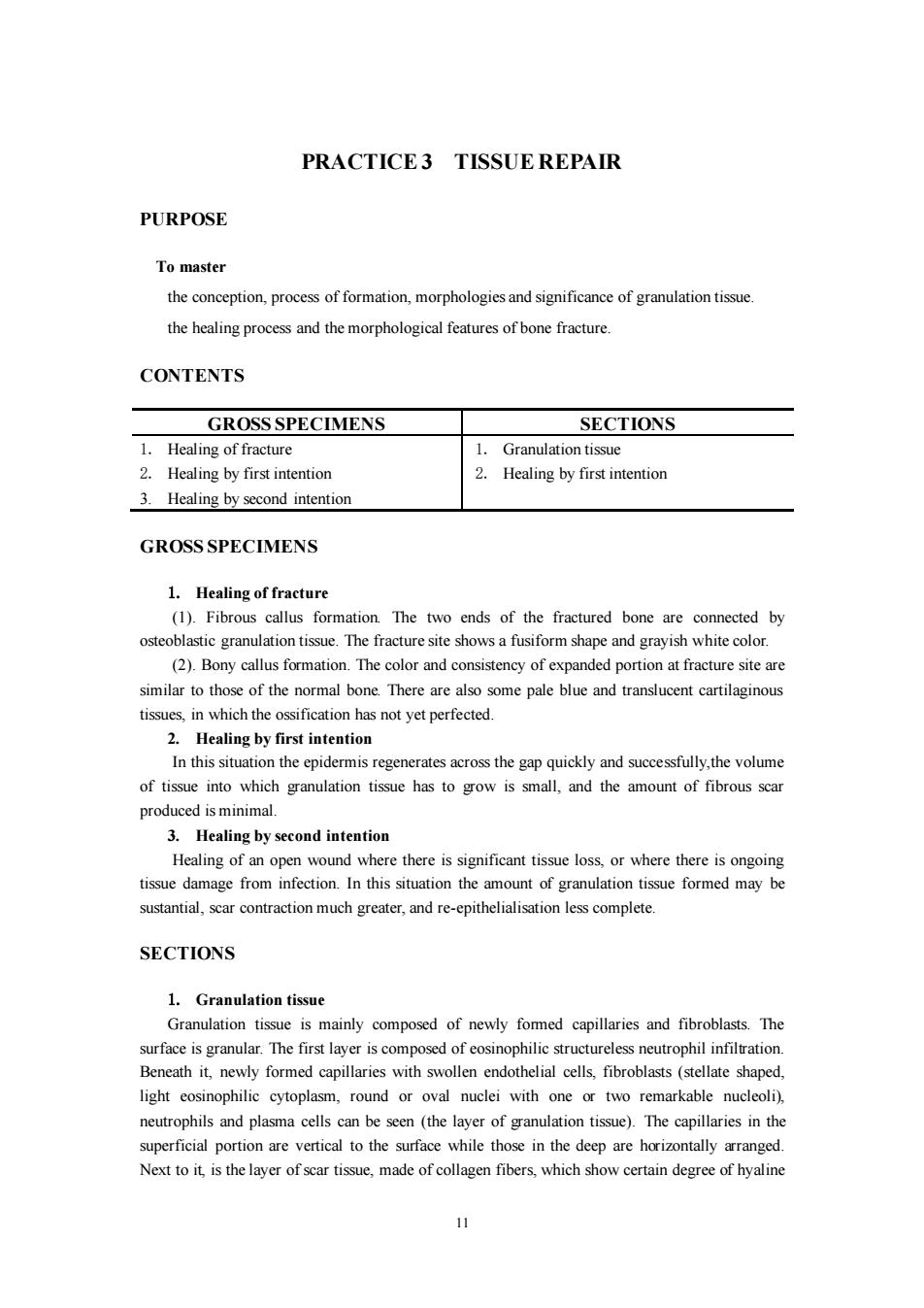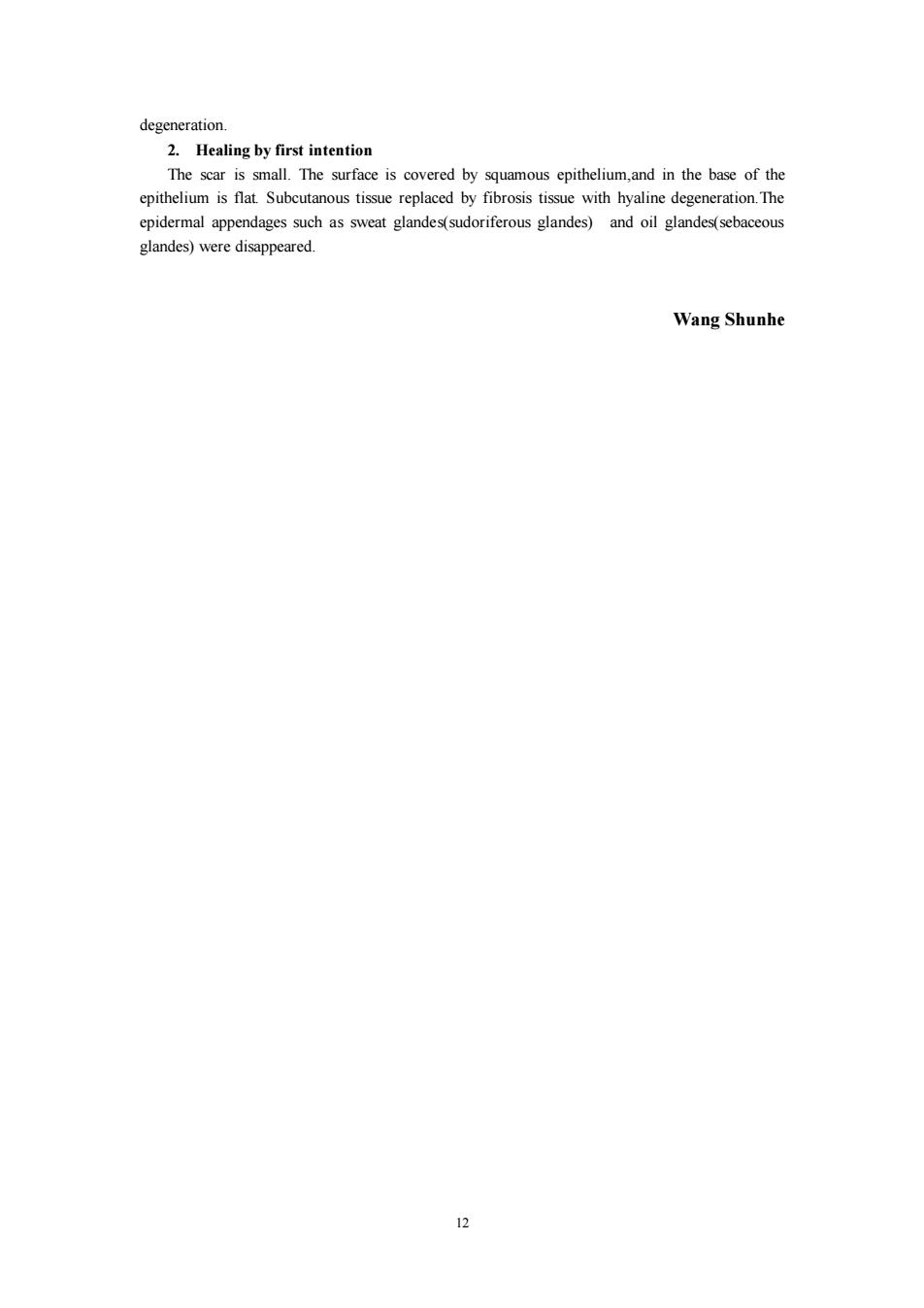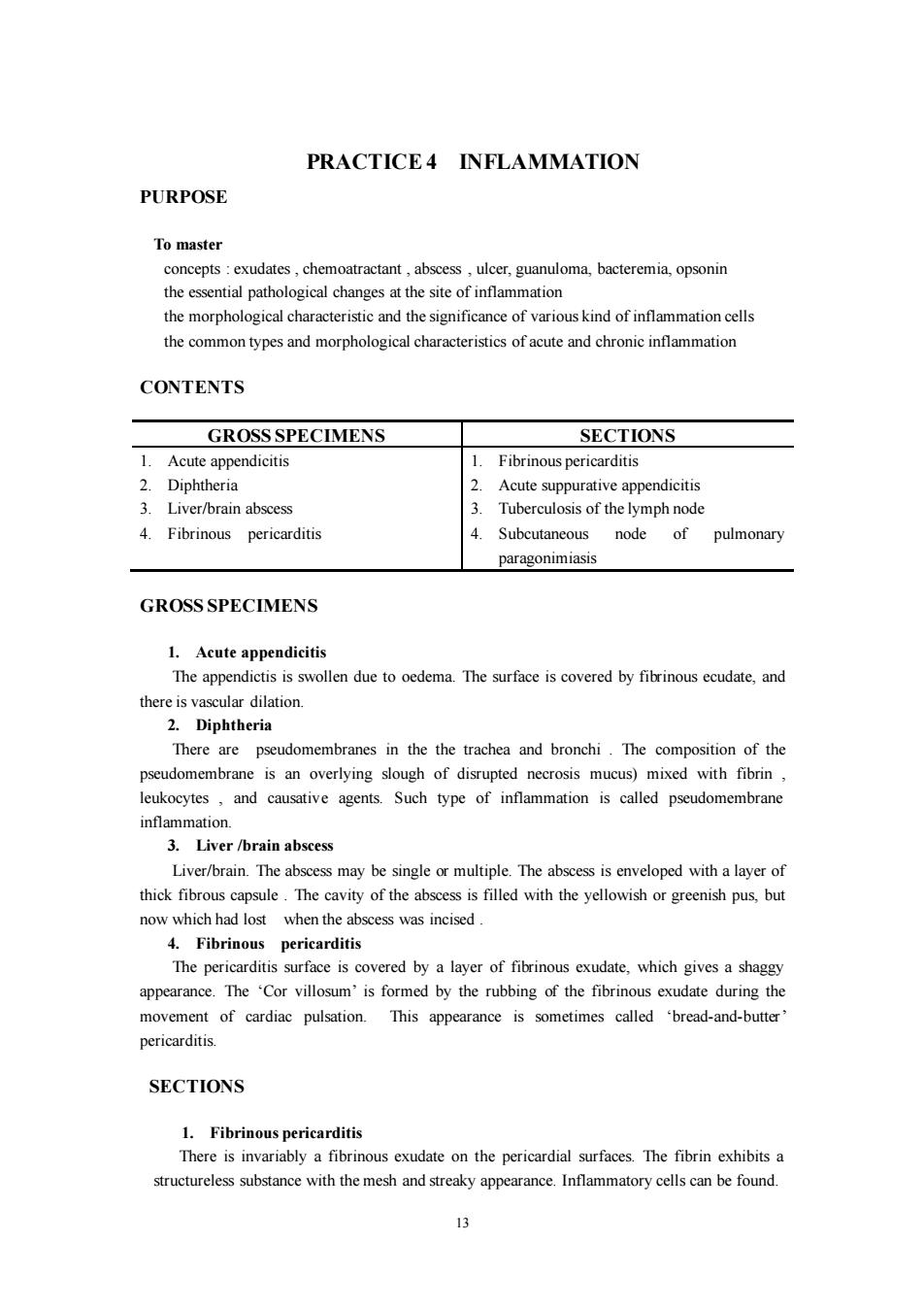
PRACTICE3 TISSUE REPAIR PURPOSE To master the conception,process of formation,morphologies and significance of granulation tissue the healing process and the morphological features of bone fracture CONTENTS GROSS SPECIMENS SECTIONS 2a 1. Granulation tissue Healing by first intention 3.Healing by second intention GROSS SPECIMENS 1.Healing of fracture (1).Fibrous callus formation.The two ends of the fractured bone are connected by osteoblastic granulation tissue.The fracture site shows a fusiform shape and grayish white color (2).Bony callus formation.The color and consistency of expanded portion at fracture site are similar to those of the normal bone.There are also some pale blue and translucent cartilaginous issuesin which has not yet perfected 2.Healing by first intention In this situation the epidermis regenerates across the gap quickly and successfully,the volume of tissue into which granulation tissue has to gow is small,and the amount of fibrous scar produced isminimal. 3.Healing by second intention Healing of an ope re there is significant tissue loss or where there is ongoing tissue damage from infection.In this situation the amount of granulation tissue formed may be sustantial,scar contraction much greater,and re-epithelialisation less complete. SECTIONS 1.Granulation tissue Granulation tissue is mainly composed of newly formed capillaries and fibroblasts.The ular The first laye newy formed capillaries wth solle eosino ial cells,fibroblasts (stellate shaped light eosinophilic cytoplasm.round or oval nuclei with one or two remarkable nucleoli). neutrophils and plasma cells can be seen (the layer of granulation tissue).The capillaries in the superficial portion are vertical to the surface while those in the deep are horizontally arranged. Next to it is the layer of scar tissue.made of collagen fibers.which show certain degree of hyaline
11 PRACTICE 3 TISSUE REPAIR PURPOSE To master the conception, process of formation, morphologies and significance of granulation tissue. the healing process and the morphological features of bone fracture. CONTENTS GROSS SPECIMENS SECTIONS 1. Healing of fracture 2. Healing by first intention 3. Healing by second intention 1. Granulation tissue 2. Healing by first intention GROSS SPECIMENS 1. Healing of fracture (1). Fibrous callus formation. The two ends of the fractured bone are connected by osteoblastic granulation tissue. The fracture site shows a fusiform shape and grayish white color. (2). Bony callus formation. The color and consistency of expanded portion at fracture site are similar to those of the normal bone. There are also some pale blue and translucent cartilaginous tissues, in which the ossification has not yet perfected. 2. Healing by first intention In this situation the epidermis regenerates across the gap quickly and successfully,the volume of tissue into which granulation tissue has to grow is small, and the amount of fibrous scar produced is minimal. 3. Healing by second intention Healing of an open wound where there is significant tissue loss, or where there is ongoing tissue damage from infection. In this situation the amount of granulation tissue formed may be sustantial, scar contraction much greater, and re-epithelialisation less complete. SECTIONS 1. Granulation tissue Granulation tissue is mainly composed of newly formed capillaries and fibroblasts. The surface is granular. The first layer is composed of eosinophilic structureless neutrophil infiltration. Beneath it, newly formed capillaries with swollen endothelial cells, fibroblasts (stellate shaped, light eosinophilic cytoplasm, round or oval nuclei with one or two remarkable nucleoli), neutrophils and plasma cells can be seen (the layer of granulation tissue). The capillaries in the superficial portion are vertical to the surface while those in the deep are horizontally arranged. Next to it, is the layer of scar tissue, made of collagen fibers, which show certain degree of hyaline

degeneration. 2.Healing by first intention The scar is smal The surface is covered by squamous epithelium,and in the base of the epithelium is flat.Subcutanous tissue replaced by fibrosis tissue with hyaline degeneration.The epidermal appendages such as sweat glandes(sudoriferous glandes)and oil glandes(sebaceous glandes)were disappeared. Wang Shunhe
12 degeneration. 2. Healing by first intention The scar is small. The surface is covered by squamous epithelium,and in the base of the epithelium is flat. Subcutanous tissue replaced by fibrosis tissue with hyaline degeneration.The epidermal appendages such as sweat glandes(sudoriferous glandes) and oil glandes(sebaceous glandes) were disappeared. Wang Shunhe

PRACTICE 4 INFLAMMATION PURPOSE To master concepts:exudates chemoatractant abscess ulcer.guanuloma.bacteremia opsonin the the common types and morphological characteristics of acute and chronic inflammation CONTENTS GROSS SPECIMENS SECTIONS Acute appendicitis 12 Fibrinous pericarditis Diphtheria Acute suppurative appendicitis 3.Liver/brain abscess 3.Tuberculosis of the lymph node 4.Fibrinous pericarditis 4.Subcutaneous node of pulmonary paragonimiasis GROSS SPECIMENS 1.Acute appendicitis The appendictis is swollen due to oedema.The surface is covered by fibrinous ecudate,and there is vascular dilation 2.Diphtheria There are pseudomembranes in the the trachea and bronchi.The composition of th pseudomembrane is an overlying slough of disrupted necrosis mucus)mixed with fibrin leukocytes,and causative agents.Such type of inflammation is called pseudomembrane inflammation. 3.Liver/brain abscess Liver/brain.The abscess may be.The abscess is enveloped with alayer of thick fibrous capsule The cavity of the abscess is filled with the yellowish or greenish pus but now which had lost when the abscess was incised. 4.Fibrinous pericarditis The pericarditis surface is covered by a laver of fibrinous exudate.which gives a shaggy appearance.The Cor villosum'is formed by the rubbing of the fibrinous exudate during the movement of cardiac pulsation. bread-and-butte pericarditis. SECTIONS 1.Fibrinous pericarditis There is invariably a fibrinous exudate on the pericardial surfaces.The fibrin exhibits a structureless substance with the mesh and streaky appearance.Inflam matory cells can be found. 13
13 PRACTICE 4 INFLAMMATION PURPOSE To master concepts : exudates , chemoatractant , abscess , ulcer, guanuloma, bacteremia, opsonin the essential pathological changes at the site of inflammation the morphological characteristic and the significance of various kind of inflammation cells the common types and morphological characteristics of acute and chronic inflammation CONTENTS GROSS SPECIMENS SECTIONS 1. Acute appendicitis 2. Diphtheria 3. Liver/brain abscess 4. Fibrinous pericarditis 1. Fibrinous pericarditis 2. Acute suppurative appendicitis 3. Tuberculosis of the lymph node 4. Subcutaneous node of pulmonary paragonimiasis GROSS SPECIMENS 1. Acute appendicitis The appendictis is swollen due to oedema. The surface is covered by fibrinous ecudate, and there is vascular dilation. 2. Diphtheria There are pseudomembranes in the the trachea and bronchi . The composition of the pseudomembrane is an overlying slough of disrupted necrosis mucus) mixed with fibrin , leukocytes , and causative agents. Such type of inflammation is called pseudomembrane inflammation. 3. Liver /brain abscess Liver/brain. The abscess may be single or multiple. The abscess is enveloped with a layer of thick fibrous capsule . The cavity of the abscess is filled with the yellowish or greenish pus, but now which had lost when the abscess was incised . 4. Fibrinous pericarditis The pericarditis surface is covered by a layer of fibrinous exudate, which gives a shaggy appearance. The ‘Cor villosum’ is formed by the rubbing of the fibrinous exudate during the movement of cardiac pulsation. This appearance is sometimes called ‘bread-and-butter’ pericarditis. SECTIONS 1. Fibrinous pericarditis There is invariably a fibrinous exudate on the pericardial surfaces. The fibrin exhibits a structureless substance with the mesh and streaky appearance. Inflammatory cells can be found